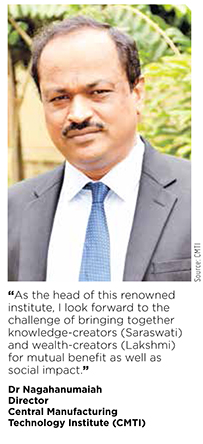Leading by Example

Industry 4.0 and emerging technologies such as the IoT, artificial intelligence, robotics and additive manufacturing are spurring the development of new production techniques and business models that will fundamentally transform production. How is the adoption of these trends by the Indian industry?
Dr Nagahanumaiah : Industry 4.0 (I4.0) technologies imply paradigm shifts in all aspects of manufacturing through digitization, automation and integration. Instead of looking at I4.0 as a threat, Indian Industries need to see them as business enablers and opportunities.
Manufacturing companies can benefit by becoming ‘smarter’ with early prediction of risks, sharing digitized data across the process chain, and integrating advanced and improved manufacturing systems – leading to enhanced value and productivity. However, I strongly advocate achieving a critical level of customization prior to adopting disruptive technologies because technology absorption largely depends on human resources. Ironically, in spite of our large population, attracting and retaining skilled manpower is becoming a major issue for most of our companies. Realizing these challenges, various arms of the government are emphasizing and supporting technical skill development through Demonstration Centers.
What, according to you, are the prime headwinds in the adoption?
Dr Nagahanumaiah : One of the major headwinds in the adoption of I4.0 technologies in India is the mindset of industries, which is due to a number of uncertainties. These include:
Skilled manpower : Availability of the right manpower is still a big issue. Retaining them is another challenge.
Low level of technology maturity : Since many disruptive technologies are being developed in parallel, their maturity level is low and their sustainability over a period is short. This calls for additional investments in future.
High operational and MOR cost : Recurring cost is expected to be quite high owing to limited resources and proprietary technologies including consumables and spares.
Cost vs. benefits : As of yet, there is no established and demonstrated cost benefit analysis. One of the biggest questions in the minds of investors is whether I4.0 technologies will bring added market. If yes, will it be same for all sectors.
How well positioned is India to shape and benefit from the changing nature of production in the future?
Dr Nagahanumaiah : The availability of a huge base of engineering and science graduates makes it easier to introduce I4.0 technologies in Indian industries. However, most Indian companies are small-scale industries with limited resources to attract and retain top-end manpower. Further, companies will invest in disruptive technologies only if they are convinced about the outputs and benefits through demonstration. From the point of view of industry, particularly MSMEs, ensuring the supply chain of I4.0 technologies appropriate to the specific sectors, along with local technical support, would decide the rate of adoption. That is the reason industrial associations across sectors are looking for Demonstration Centers and Centers of Excellence rather than implementing I4.0 technologies in their business units right away.
CMTI has been playing a significant role of being a catalyst in manufacturing technology growth in the country. Under your able guidance as the Director of the institute, how do you envision its growth?
Dr Nagahanumaiah : CMTI over years has evolved as a Center of Excellence for Machine Tool and Manufacturing Process Development. As the head of this renowned institute, I look forward to the challenge of bringing together knowledge-creators (Saraswati) and wealth-creators (Lakshmi) for mutual benefit as well as social impact. It implies development of technology-intensive products, machines and processes, and licensing them to industry partners. With proven credentials in developing and productionizing a wide range of special purpose machines, CMTI is poised to become a Center of Excellence for Smart Manufacturing and Innovative Product Development. Smarter, modular and reconfigurable machine tools and their aggregates (subsystems) for both subtractive and additive manufacturing will be one of our major R&D focus, keeping in mind emerging technologies and long-term sustainability. CMTI will also continue and enhance its value-added (laboratory) services to industry, as well as training of technical professionals to make them readily employable in industry or entrepreneurs creating new jobs for others.

The Heavy Industries and Public Enterprises Ministry is supporting setting up of four centers in the country to facilitate SMEs implement Industry 4.0 of which one will be in CMTI, Bengaluru. Could you tell us about the fashion in which the centers plan to spread the awareness on Smart Manufacturing Technologies?
Dr Nagahanumaiah : As mentioned earlier, Indian companies, particularly SMEs, look for well-demonstrated manufacturing technologies to de-risk their investments. This is one of the reasons our parent department HE&PE is establishing four centers to empower SMEs toward implementing I4.0 technologies for the benefit of Capital Goods sector. In our center at CMTI, we have two objectives. The first is demonstrating the concept of Smart Manufacturing – Factories of Future, which would provide an opportunity for MSMEs to touch and feel the benefits of the concept as well as use this center to cost-effectively train their manpower. The second and rather more important objective is to indigenously design and develop IoT-enabled smart manufacturing machines and systems to demonstrate the capabilities in real shop-floor environment.
We strongly believe in Active Learning, driven by a quote by philosopher Confucius: “I hear and I forget. I see and I remember. I do and I understand”. CMTI is committed to enhance our competence in the complete process chain of I4.0, including process prediction, digitization and data sharing, process analytics, and development of smart machines based on modular designs. In this initiative, we are already associated with IMTMA, that would play a pivotal role in analyzing and defining the need of Indian machine tool industries. I believe the other three centers are also treading a similar path.



 Facebook
Facebook.png) Twitter
Twitter Linkedin
Linkedin Subscribe
Subscribe